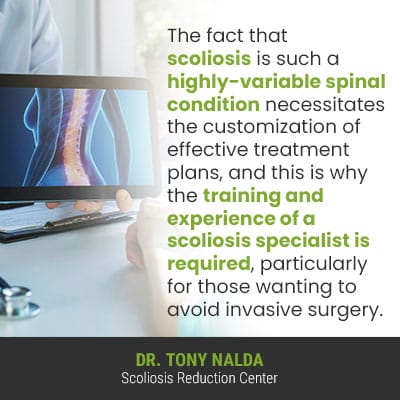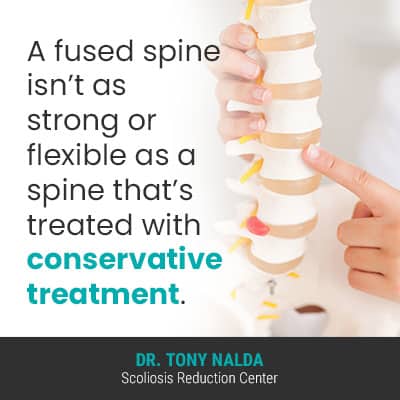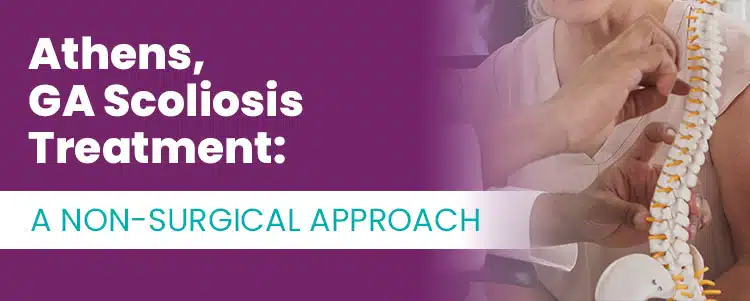As the leading spinal condition amongst school-aged children, scoliosis is a highly-prevalent spinal condition. Following a diagnosis of scoliosis, the most important decision to make is how to treat it moving forward; different treatment approaches offer patients different potential results.
There are two main scoliosis treatment approaches for patients to choose between: traditional and conservative. For residents of Athens, GA, a non-surgical conservative scoliosis treatment center led by Dr. Tony Nalda is a 7.5-hour drive, and 458 miles away.
Let’s start our exploration of Athens scoliosis treatment by first defining the condition and explaining why being proactive with treatment is so important.
Understanding Scoliosis
Being diagnosed with scoliosis means an unnatural sideways spinal curve has developed, and in addition to bending unnaturally to the side, a scoliotic curve also has a rotational component, making it twist and a 3-dimensional spinal condition.
Scoliosis is progressive, meaning its nature is to get worse over time; only proactive treatment can work towards counteracting the condition’s progressive nature.
Scoliosis can range from mild to moderate and severe to very severe, and this is also the condition’s progressive line.
Even scoliosis diagnosed as mild doesn’t mean that’s where it will stay, and while we don’t always understand what triggers the initial onset of scoliosis, we do know what triggers its progression: growth and development.
So for children and adolescents who have not yet reached skeletal maturity, they are at the highest risk of rapid-phase progression, particularly for patients in the stage of puberty, characterized by rapid and unpredictable growth spurts.
In patients who are still growing, however, the condition isn’t known to be overly painful because scoliosis doesn’t become a compressive condition until adulthood; this is one of the challenges of early detection.
Not only is scoliosis progressive and ranges widely in severity, there are also multiple different types of scoliosis patients can develop.
Different Types of Scoliosis
The most prevalent type of scoliosis overall is idiopathic scoliosis, and the idiopathic designation means we don’t know what triggers its onset, and the most prevalent type of idiopathic scoliosis is adolescent idiopathic scoliosis (AIS), diagnosed between the ages of 10 and 18.
Idiopathic scoliosis accounts for approximately 80 percent of known diagnosed scoliosis cases, and the remaining 20 percent consist of types associated with known causes: neuromuscular scoliosis, degenerative scoliosis, and congenital scoliosis.

The fact that scoliosis is such a highly-variable spinal condition necessitates the customization of effective treatment plans, and this is why the training and experience of a scoliosis specialist is required, particularly for those wanting to avoid invasive surgery.
So let’s now move on to exploring the two main types of scoliosis treatment: traditional vs conservative.
Traditional Scoliosis Treatment
The main issue I have with traditional scoliosis treatment is that it’s more reactive than proactive, and as a progressive condition, a proactive approach is required to work towards preventing increasing condition severity.
Traditional treatment funnels patients towards spinal fusion surgery because it doesn’t have a strategy for treating scoliosis while mild, only when it progresses to become severe, when patients become surgical candidates.
Spinal fusion surgery has the goal of stopping progression, and does so by fusing the curve’s most-tilted vertebrae into one solid bone; this eliminates movement (progression) in the area as the vertebral bodies can’t become more tilted.
Often, rods are attached to the spine with pedicle screws to hold it in place, and these rods are permanent.

A fused spine isn’t as strong or flexible as a spine that’s treated with conservative treatment.
Conservative Scoliosis Treatment
Here at the Scoliosis Reduction Center®, residents of Athens, Ga have only a 7.5-hour drive between them and world-class conservative scoliosis treatment with proven results.
Celebration, Orlando is home to Dr. Tony Nalda’s treatment center that allows patients to access multiple condition-specific treatment disciplines under one roof; this is something that many people cross the country, and the globe, for.
By integrating different treatment modalities, I can fully customize each and every treatment plan by apportioning the different forms of treatment accordingly, based on how the spine is responding to treatment.
Chiropractic care can work towards impacting scoliosis on a structural level by manually adjusting the position of the curve’s most-tilted vertebrae, and physical therapy can help strengthen the spine’s surrounding muscles so they can provide it with optimal support and stabilization.
Corrective bracing is known to be particularly effective on growing spines and can help augment corrective results by pushing the spine into a corrective position.
Rehabilitation involves guidance on how to lead a scoliosis-friendly lifestyle and a series of custom-prescribed exercises to help patients establish a home-rehabilitation program for long-term sustainable treatment results.
Conclusion
While spinal fusion still has a place in scoliosis treatment, the reality is that many cases of scoliosis can be treated non-surgically, and the Scoliosis Reduction Center® has been producing the type of results that highlight the shortfalls of traditional scoliosis treatment for years.
Those in search of Athens, Ga scoliosis treatment have access to leading scoliosis chiropractor, Dr. Tony Nalda, within a 457-mile drive.
The most important thing to know about scoliosis is that as a progressive condition, the best time to start treatment is always now.
Scoliosis is a structural spinal condition that has to, first and foremost, be impacted on a structural level, and through chiropractic care, this can be achieved through a curvature reduction.
Physical therapy can help by increasing core strength so the spine is optimally supported, and corrective bracing further stabilizes the spine.
Rehabilitation is important for giving patients the tools they need, and the knowledge they need, to lead scoliosis-friendly lives while caring for their spines.




